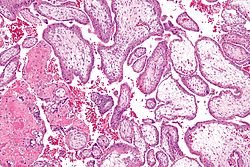Chorionic villus
| Chorionic villi | |
|---|---|

Micrograph showing chorionic villi. Intermediate magnification. H&E stain.
|
|

Micrograph showing chorionic villi. Very high magnification. H&E stain.
|
|
| Details | |
| Days | 24 |
| Identifiers | |
| MeSH | Chorionic+Villi |
|
Anatomical terminology
[]
|
|
Chorionic villi are that sprout from the chorion to provide maximum contact area with maternal blood.
They are an essential element in pregnancy from a histomorphologic perspective, and are, by definition, a product of conception. Branches of the umbilical arteries carry embryonic blood to the villi. After circulating through the capillaries of the villi, blood returns to the embryo through the umbilical vein. Thus, villi are part of the border between maternal and fetal blood during pregnancy.
Villi can also be classified by their relations:
The chorion undergoes rapid proliferation and forms numerous processes, the chorionic villi, which invade and destroy the uterine decidua and at the same time absorb from it nutritive materials for the growth of the embryo. They undergo several stages, depending on their composition.
Until about the end of the second month of pregnancy, the villi cover the entire chorion, and are almost uniform in size—but after then, they develop unequally.
The bulk of the villi consist of connective tissues that contain blood vessels. Most of the cells in the connective tissue core of the villi are fibroblasts. Macrophages known as Hofbauer cells are also present.
In 1983, an Italian biologist named Giuseppe Simoni discovered a new method of prenatal diagnosis using chorionic villi.
Chorionic villi are a rich source of stem cells. Biocell Center, a biotech company managed by Giuseppe Simoni, is studying and testing these types of stem cells. Chorionic stem cells, like amniotic stem cells, are uncontroversial multipotent stem cells.
Section through the embryo.
Transverse section of a chorionic villus.
Primary chorionic villi. Diagrammatic.
Secondary (Tertiary? Vessels are present.) chorionic villi. Diagrammatic.
Human embryo of about 28 days, with yolk-sac.
This article incorporates text in the public domain from the 20th edition of Gray's Anatomy (1918)
...
Wikipedia
